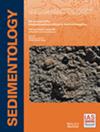加拿大东南部新斯科舍省早石炭世裂陷和冈瓦南冰川作用下的湖泊沉积构型
IF 2.8
2区 地球科学
Q1 GEOLOGY
引用次数: 0
摘要
上古生界湖盆沉积不仅记录了局部构造活动,而且是评价与晚古生代冈瓦南冰期有关的全球古气候变化的档案。加拿大东南部新斯科舍省的Tournaisian Horton群是在冈瓦南地区最后一次向阿巴拉契亚山脉扩张之后,在裂谷盆地中形成的。经典蓝滩剖面(约353.5 ~ 352 Ma)的砂岩和页岩的沉积学、矿物学和地球化学揭示了局部构造作用和全球气候控制对湖泊沉积的相互作用。湖相沉积环境由剖面底部的近海深水环境逐渐过渡到剖面顶部以波浪和河流为主的近岸环境。多个小海侵-退积旋回的平均持续时间为21 ka,可能与米兰科维奇旋回有关。异常丰富的软沉积变形构造和滑坡是裂谷沉降最活跃阶段频繁地震的沉积反应。整体演替表现为湖盆由浅上平衡填向过填的变化。化学风化强度指数和Th/K比值表现出较长期的变化趋势,从剖面较低的干冷条件向顶部较近的湿润温暖条件过渡,过渡时期变化较快。该剖面记录了全球中图尔奈世碳同位素偏移的峰值和相应的冷却事件(354 Ma至约351 Ma)。在软沉积变形构造记录的裂谷盆地最大沉降期间,沉积演替是对长期和短期气候循环影响湖泊水位和沉积物供应的响应。本文章由计算机程序翻译,如有差异,请以英文原文为准。
Architecture of lacustrine deposits in response to early Carboniferous rifting and Gondwanan glaciation, Nova Scotia, south‐east Canada
Abstract Upper Palaeozoic lacustrine basin deposits not only record local tectonism but are also an archive to evaluate global palaeoclimate changes linked to the Late Palaeozoic Gondwanan ice age. The Tournaisian Horton Group of Nova Scotia, south‐east Canada, accumulated in rift basins following the final accretion of peri‐Gondwanan terranes to the Appalachians. Sedimentology, mineralogy and geochemistry of the well‐exposed sandstones and shales at the classic Blue Beach section ( ca 353.5 to 352 Ma) reveal the interplay of local tectonism and global climatic controls on lacustrine sedimentation. The lacustrine depositional environment gradually transitioned from deep water offshore at the base of the section to wave‐dominated and fluvial‐dominated nearshore at the top. Multiple small transgressive–regressive sedimentation cycles have an average 21 ka duration, likely related to Milankovitch cyclicity. Unusually abundant soft‐sediment deformation structures and landslides are the sedimentary responses to frequent earthquakes during the most active phase of rift subsidence. The overall succession shows changes from a shallowing‐up balanced‐filled to an overfilled lacustrine basin. The chemical weathering intensity index and the Th/K ratio show a longer‐term trend from dry and cool conditions low in the section to humid and warm conditions near the top, with rapid change in the transition period. The section records the peak of the global mid‐Tournaisian carbon isotope excursion and the corresponding cooling event (354 Ma to approximately 351 Ma). The sedimentary succession is a response to long‐term and short‐term climatic cycles influencing lake level and sediment supply during the time of maximum rift basin subsidence recorded by the soft‐sediment deformation structures.
求助全文
通过发布文献求助,成功后即可免费获取论文全文。
去求助
来源期刊

Sedimentology
地学-地质学
CiteScore
8.20
自引率
11.40%
发文量
94
审稿时长
6-12 weeks
期刊介绍:
The international leader in its field, Sedimentology publishes ground-breaking research from across the spectrum of sedimentology, sedimentary geology and sedimentary geochemistry.
Areas covered include: experimental and theoretical grain transport; sediment fluxes; modern and ancient sedimentary environments; sequence stratigraphy sediment-organism interaction; palaeosoils; diagenesis; stable isotope geochemistry; environmental sedimentology
 求助内容:
求助内容: 应助结果提醒方式:
应助结果提醒方式:


